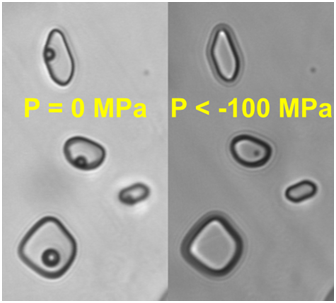
L’eau, plus anormale que jamais
Vincent Holten, Emmanuel Guillerm & Frédéric Caupin (equipe Liquides et Interfaces), avec des collègues de Bern et Potsdam, ont publié un article intitulé "Compressibility anomalies in stretched water and their interplay with density anomalies" dans la revue Journal of Physical Chemistry Letters.

Water: more anomalous than ever
Vincent Holten, Emmanuel Guillerm & Frédéric Caupin (team Liquids and Interfaces), with colleagues from Bern and Potsdam, have published an article entitled "Compressibility anomalies in stretched water and their interplay with density anomalies" in the journal Journal of Physical Chemistry Letters.
La glace flotte sur l’eau, l’eau à 4°C est plus dense qu’à 0°C : voici deux des très nombreuses anomalies de l’eau. Les théories proposées pour expliquer ces anomalies ne manquent pas, mais jusqu’à maintenant les expériences n’étaient pas parvenues à les départager. Les auteurs ont étudié l’eau à pression négative, c’est-à-dire soumise à une traction mécanique. Ils utilisent un laser pour sonder l’eau dans ces conditions extrêmes, jusqu’à moins mille fois la pression atmosphérique ! En mesurant d’infimes changements de couleur de la lumière diffusée par l’échantillon (spectroscopie Brillouin), on obtient la vitesse du son dont sont déduites d’autres grandeurs (pression, compressibilité…). On peut ainsi suivre à pression négative les anomalies déjà connues à pression positive, mais aussi en détecter de nouvelles. Cette découverte limite les explications possibles pour le comportement de l’eau, laissant seulement deux théories en lice.
Ice floats on water, water at 4°C is denser than at 0°C: here are two among many anomalies of water. The theories proposed to explain these anomalies are not lacking, but so far the experiments have not managed to separate them. The authors studied water at negative pressure, that is to say subjected to mechanical traction. They use a laser to probe the water in these extreme conditions, down to minus one thousand times the atmospheric pressure! By measuring minute changes in the color of the light scattered by the sample (Brillouin spectroscopy), the speed of sound is obtained and used to deduce other quantities (pressure, compressibility ...). It is thus possible to follow at negative pressure the anomalies already known at positive pressure, but also to detect new anomalies. This discovery limits the possible explanations for the behavior of water, leaving only two theories in contention.
16/11/2017

Gouttes d’eau micrométriques piégées dans du quartz à l’équilibre avec la vapeur (gauche) ou à pression négative (droite)
Micrometric water drops trapped in quartz in equilibrium with vapor (left) or at negative pressure (right)

















